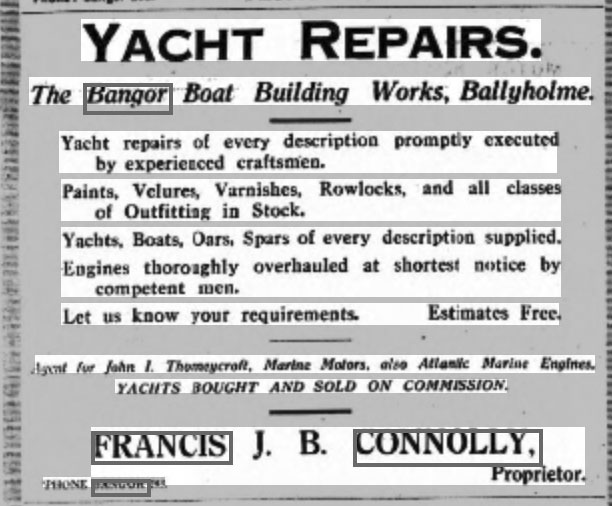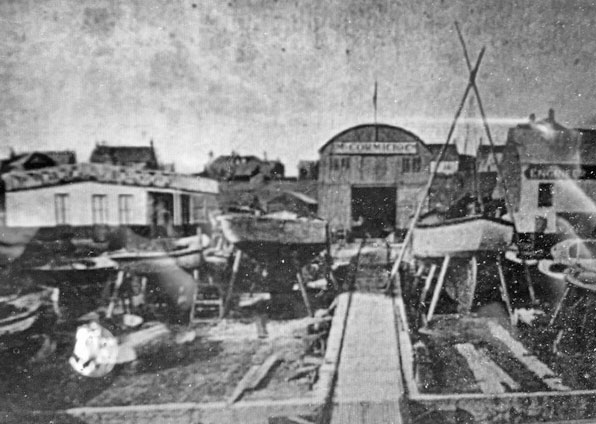Did you know that before Enrico Caproni built his famous Palais de Dance in 1928 on Seacliff Road that there was a shipyard on that site on the corner of Seaforth Road?
In fact, there were two businesses carrying out shipbuilding and associated work in Ballyholme. In March 1919 Chesney McCormick and Francis J B Connolly together applied for permission to build a ‘Workshop or shed of brick, roofed with slates’ on the west side of Seacliff Road. Connolly was an architect and civil engineer and the 1911 Census shows he lived on Bryansburn Road when he was 23. There are also reports of him being elected as a student member of the Ulster Society of Architects in 1906. In December 1919 McCormick lodged plans for a temporary ‘Boat house and Spar shed’ on Seacliff Road near College Gardens, a terrace part of which became the Ballyholme Hotel.

Advert in the Belfast Newsletter, 16 July 1921
In 1920 and 1921 Connolly was advertising under the name Bangor Boat Building Works and in April 1923 McCormick and the Bangor Boat Building Works applied to build a ‘Wooden shop and dwelling’ on the south side of Seaforth Road. The launching slip for the yard was opposite and can still be seen today beside Ballyholme Yacht Club.

Advert from Bangor Street Directory
Pictorial records show that McCormick & Co had a shed where Kingsland Nursing Home is today, and this appears to be the location where the Shipyard business carried on into the future. It provided winter storage for the local racing yachts such as Dancers and Rivers and for yachts and motorboats up to 20 tons and built a launching slip opposite. It had a distinctive curve and is still there today. McCormick & Co didn’t last long and on 30th October 1924 the business was advertised for sale. The reason for the demise can be seen in a letter of reference from McCormick & Co in the Public Record Office in respect of a Robert Eddys of Ballymagee Street (High Street) Bangor, which shows that he was an ex-seaman and a rigger and was dismissed owing to shortage of work. The date is 24th October 1924.

Sale of McCormick yard, Belfast Newsletter 30 October 1924
Enrico Caproni may have foreseen the demise of the business on the corner of Seaforth Road for in June 1923 he submitted plans for ‘Refreshment Rooms and a temporary shop’. The Bangor Boat Building Works faded from record, but it is known that the slip was transferred to the sailing club at Ballyholme which at the time met in the clubhouse on Kingsland which is now the Table Tennis club. The slip can still be seen today at low tide.

McCormick's yard in the 1920s

Shipyard Co Ltd staff in the 1920s
The McCormick business was bought by a Mr W J Lovett, who was one of the Senior Naval Architects and a Director in the Workman Clark & Co shipyard in Belfast. He called the business The Shipyard Company Ltd and in 1925 added a store. By this time Caproni had his café which he called the Mirimar.

Lovett's Shipyard showing Rivers in winter storage
In 1926 Mr Lovett asked Robert (Bertie) Slater, a naval architect in Workman Clark’s, to manage the yard. Prior to the liquidation of the company McCormick was building yachts of the Dancing class for Royal Ulster Yacht Club.
The completion of two Dancing Class yachts which had been abandoned was Bertie Slater’s first job. The yard also built ships lifeboats for the Port Line whose liners were being constructed by Workman Clark.
In 1930 the yard built one of the largest boats, a 50 ft passenger-carrying cabin launch for the Lough Erne Boat Co. It made the passage to Belfast under its own power and was then lifted onto a special railway truck and transported to Enniskillen where it was launched into Lower Lough Erne. The shipyard also built six cabin cruisers for Hyland Ltd and in 1934 a 35ft Motor Yacht, the Moya, for Mr Lovett and to his own design.

The passenger boat for Lough Erne
In 1932 Bertie Slater lodged plans for an ‘Iron Shed’. He had married and settled in Ballyholme in 1928 and by 1937 he owned the yard. The late Thirties was a time of slump and little money and the yard struggled to survive. During the war the yard was very busy with Admiralty work. In addition to maintaining a large fleet of patrol boats and trawlers, the yard built Torpedo Recovery Boats for Lough Neagh. Some of the boats in Bangor had escaped from occupied Norway, Holland, France and Belgium.
Towards the end of the war Slater built 50-foot-long flat-bottomed Scows for magnetic mine sweeping and 36-foot Harbour Launches, some of which were used at Arromanches, one of the D Day beaches. He was also asked by the Admiralty if he could build 112-foot wooden Minesweepers. For this he identified a suitable site at nearby Groomsport and requested a grant of £10k for a slip, shed, winch and machinery, but was refused. Years later he was told if he had asked for £100k he would have got it!
Slater’s upper yard had a large shed for boat building and repairs. The rest was used for Winter storage and Spring fitting out of yachts and motorboats. The fact that boats could be driven ashore from their moorings in the Bay in onshore gales, provided the yard with extra business for repairs.
Slater subsequently built a sheet metal workshop to cope with Ventilation Trunking for mills and factories. The shipyard installed the ventilation ducting in The Tonic Cinema in the late Thirties. A second building shed was constructed alongside the original shed to cope with RNLI repairs and maintenance.
After the war Slater designed the S Class cruiser, a superb affordable sailing yacht built in the traditional way by skilled craftsmen. The S-class boats are sturdy cruisers, well suited to Irish and Scottish waters. Many of these yachts are still sailing today.
In 1958 Bruce Cowley, who had retired from HMRC, bought the yard. Cowley continued the S Class production, making a total of 22 built in Bangor between 1946 and 1964. He also built well-known large cruising yachts; Jaynor for Ivan Selig built with the Fastnet race in mind, the famous Duncrue for Sean McNeill, and Trasna of Ely for the Duke of Westminster on Lough Erne.

The arrival of the hull of Duncrue
In 1969 the yard was in receivership and Frank Smyth, who at this time owned a small boat yard in Donaghadee and a chandlery in Bangor, bought the business and for a time traded as Bangor Yacht Supply Co. In 1975 it became Bangor Shipyard Ltd. When Frank started the workshop had an earthen floor and very old equipment which he replaced with gear from the Donaghadee workshop.
His venture into boat building began with three small wooden punts and then with the introduction of fibreglass, Smyth made his own small dinghy moulds and began producing them. He subsequently shipped in fibreglass hulls from England and fitted them out. These he sold in the small chandlery in Bangor. The first big job in the Shipyard was repairing Velia for the well-known hotelier, George Ralston, and the yard was also recognized for the repair of the Donaghadee, Aranmore, Cloughey and Portrush lifeboats. The lifeboat work was suspended by the RNLI for fear of terrorist action (this was during the Troubles) but Smyth grasped the opportunity and obtained the contract for repairing two pilot boats from Carrickfergus which were damaged by an explosion.

The Velia
Up until this time Smyth had to lay rails in sections on the road on which to make the transfer from the yard to the slip, which took at least an hour. Frank approached the then Town Surveyor, Martin Gray, who persuaded the Council to allow rails to be embedded in concrete in the road to make the movement smoother and easier. On one notable occasion the Seacliff Road had been blocked when the concrete rail bedding collapsed due to the fish plates not having been fitted properly!
Another improvement resulted from the purchase of a secondhand winch (which was to have been scrapped) from the Belfast aerospace company Short Bros for £25 and an ex RAF tractor bought in an auction for £100. Frank also acquired a hydraulic crane and for several years, Fred, the crane driver was in demand across the country for lifting boats.
Building and repairing fishing boats formed a substantial part of the business. This developed into a full-blown boat building business with a sizeable workforce. Many of the names will be familiar to seafarers – Elias Scott (Scottie) who was awarded a BEM, Willie Harvey, Ken Bewley, Jimmy Hamilton and Norman Henry. Government grants for fishing boats made the financial situation easier and this part of the yard flourished for about ten years. At this point Smyth was building larger fishing boats of 70 feet in length and to accommodate these he demolished the old shed and built a larger one. The maintenance and refurbishment of RNLI lifeboats also formed a large part of the business.

Scotty with his BEM
Among the many fishing boats Smyth fitted out was the 30-ton Ros Mor for local fisherman, the late Jack Miller. The Fragrant Cloud, Xmas Star and the Jubilee Star, the Sarna and the Iona were other craft among many. The latter was built for Tommy Cecil of Rathlin. It was the first fully decked ferry boat built for trade between Ballycastle and Rathlin. Subsequently, to Frank’s surprise, Tommy asked for the decks to be strengthened. It turned out he was carrying cattle, cars and caravans!

The launch of Sarnia
By this time the Government had built sophisticated slips at Kilkeel and Portavogie, wooden construction was diminishing, and grants were cut, all making boatbuilding difficult. Then came Bangor Marina. Smyth was invited to tender for the Bangor boatyard contract, but for him this was unworkable and as boatbuilding at Ballyholme was no longer viable the yard closed in 1991.

The old slipway at Ballyholme
I would like to acknowledge the help in gathering this information of Ronnie Slater, son of one of the owners and Frank Smyth, the last owner of the yard. Also, of Leanne Briggs of North Down Museum, and of the Public Record Office.
